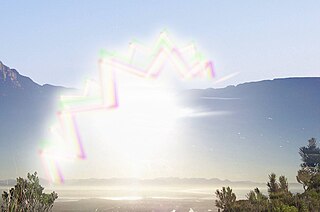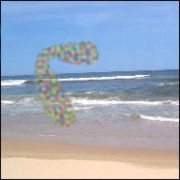Related Research Articles

Migraine is a common neurological disorder characterized by recurrent headaches. Typically, the associated headache affects one side of the head, is pulsating in nature, may be moderate to severe in intensity, and could last from a few hours to three days. Non-headache symptoms may include nausea, vomiting, and sensitivity to light, sound, or smell. The pain is generally made worse by physical activity during an attack, although regular physical exercise may prevent future attacks. Up to one-third of people affected have aura: typically, it is a short period of visual disturbance that signals that the headache will soon occur. Occasionally, aura can occur with little or no headache following, but not everyone has this symptom.

An epileptic seizure, informally known as a seizure, is a period of symptoms due to abnormally excessive or synchronous neuronal activity in the brain. Outward effects vary from uncontrolled shaking movements involving much of the body with loss of consciousness, to shaking movements involving only part of the body with variable levels of consciousness, to a subtle momentary loss of awareness. Most of the time these episodes last less than two minutes and it takes some time to return to normal. Loss of bladder control may occur.

Headache, also known as cephalalgia, is the symptom of pain in the face, head, or neck. It can occur as a migraine, tension-type headache, or cluster headache. There is an increased risk of depression in those with severe headaches.

Micropsia is a condition affecting human visual perception in which objects are perceived to be smaller than they actually are. Micropsia can be caused by optical factors, by distortion of images in the eye, by changes in the brain, and from psychological factors. Dissociative phenomena are linked with micropsia, which may be the result of brain-lateralization disturbance.
Macropsia is a neurological condition affecting human visual perception, in which objects within an affected section of the visual field appear larger than normal, causing the person to feel smaller than they actually are. Macropsia, along with its opposite condition, micropsia, can be categorized under dysmetropsia. Macropsia is related to other conditions dealing with visual perception, such as aniseikonia and Alice in Wonderland Syndrome. Macropsia has a wide range of causes, from prescription and illicit drugs, to migraines and (rarely) complex partial epilepsy, and to different retinal conditions, such as epiretinal membrane. Physiologically, retinal macropsia results from the compression of cones in the eye. It is the compression of receptor distribution that results in greater stimulation and thus a larger perceived image of an object.
A headache is often present in patients with epilepsy. If the headache occurs in the vicinity of a seizure, it is defined as peri-ictal headache, which can occur either before (pre-ictal) or after (post-ictal) the seizure, to which the term ictal refers. An ictal headache itself may or may not be an epileptic manifestation. In the first case it is defined as ictal epileptic headache or simply epileptic headache. It is a real painful seizure, that can remain isolated or be followed by other manifestations of the seizure. On the other hand, the ictal non-epileptic headache is a headache that occurs during a seizure but it is not due to an epileptic mechanism. When the headache does not occur in the vicinity of a seizure it is defined as inter-ictal headache. In this case it is a disorder autonomous from epilepsy, that is a comorbidity.

An aura is a perceptual disturbance experienced by some with epilepsy or migraine. An epileptic aura is a seizure.
Non-epileptic seizures (NES), also known as non-epileptic events, are paroxysmal events that appear similar to an epileptic seizure but do not involve abnormal, rhythmic discharges of neurons in the brain. Symptoms include shaking, loss of consciousness, and loss of bladder control. Some people have symptoms like those epileptic seizures. But non-epileptic seizures do not involve any unusual electrical activity in the brain. They usually relate to psychological, neurological, or physical trauma. It may take time to diagnose. NES are real, and people who are suffering do not have conscious and voluntary control over them. Non-epileptic seizures are similar to epileptic seizures external, even though their cause is very dissimilar. Non-epileptic seizures may look like generalized convulsions similar to grand mal epileptic seizures. People with NES sometimes need to make some life adjustments. Seizures may affect a person’s daily activities like the ability to work and drive vehicles. Some people are confused about their condition.
Acephalgic migraine is a neurological syndrome. It is a relatively uncommon variant of migraine in which the patient may experience some migraine symptoms such as aura, nausea, photophobia, and hemiparesis, but does not experience headache. It is generally classified as an event fulfilling the conditions of migraine with aura with no headache. It is sometimes distinguished from visual-only migraine aura without headache, also called ocular migraine.
The postictal state is the altered state of consciousness after an epileptic seizure. It usually lasts between 5 and 30 minutes, but sometimes longer in the case of larger or more severe seizures, and is characterized by drowsiness, confusion, nausea, hypertension, headache or migraine, and other disorienting symptoms.

Scintillating scotoma is a common visual aura that was first described by 19th-century physician Hubert Airy (1838–1903). Originating from the brain, it may precede a migraine headache, but can also occur acephalgically, also known as visual migraine or migraine aura. It is often confused with retinal migraine, which originates in the eyeball or socket.
The International Classification of Headache Disorders (ICHD) is a detailed hierarchical classification of all headache-related disorders published by the International Headache Society. It is considered the official classification of headaches by the World Health Organization, and, in 1992, was incorporated into the 10th edition of their International Classification of Diseases (ICD-10). Each class of headache contains explicit diagnostic criteria—meaning that the criteria include quantities rather than vague terms like several or usually—that are based on clinical and laboratory observations.
Vestibular migraine (VM) is vertigo with migraine, either as a symptom of migraine or as a related neurological disorder.

Retinal migraine is a retinal disease often accompanied by migraine headache and typically affects only one eye. It is caused by ischaemia or vascular spasm in or behind the affected eye.
The classification of all headaches, including migraines, is organized by the International Headache Society, and published in the International Classification of Headache Disorders (ICHD). The current version, the ICHD-3 beta, was published in 2013.
Migralepsy is a rare condition in which a migraine is followed, within an hour period, by an epileptic seizure. Because of the similarities in signs, symptoms, and treatments of both conditions, such as the neurological basis, the psychological issues, and the autonomic distress that is created from them, they individually increase the likelihood of causing the other. However, also because of the sameness, they are often misdiagnosed for each other, as migralepsy rarely occurs.
Vertiginous epilepsy is infrequently the first symptom of a seizure, characterized by a feeling of vertigo. When it occurs, there is a sensation of rotation or movement that lasts for a few seconds before full seizure activity. While the specific causes of this disease are speculative there are several methods for diagnosis, the most important being the patient's recall of episodes. Most times, those diagnosed with vertiginous seizures are left to self-manage their symptoms or are able to use anti-epileptic medication to dampen the severity of their symptoms.
Forced Normalization (FN) is a psychological phenomenon in which a long term episodic disorder is treated, and, although the electroencephalogram (EEG) appears to have stabilized, acute behavioral, mood, and psychological disturbances begin to manifest. If, or when, treatment for the disorder is halted, the disturbances go away, but the episodic spikes on the EEG reappear. H. Landolt coined the term 'Forced Normalization' in 1953 in response to a change he witnessed in epileptic EEGs, which monitor electrical activity in the brain. These changes were followed by abrupt behavioral changes in the patient. Landolt concluded that forced normalization is "the phenomenon characterized by the fact that, with the occurrence of psychotic states, the electroencephalography becomes more normal or entirely normal, as compared with previous and subsequent EEG findings." Forced normalization, as described by Landolt, was therefore an electrophysiological phenomenon with the electroencephalograph at its helm.
Idiopathic childhood occipital epilepsy of Gastaut (ICOE-G) is a pure but rare form of idiopathic occipital epilepsy that affects otherwise normal children and adolescents. It is classified amongst benign idiopathic childhood focal epilepsies such as rolandic epilepsy and Panayiotopoulos syndrome.

Occipital epilepsy is a neurological disorder that arises from excessive neural activity in the occipital lobe of the brain that may or may not be symptomatic. Occipital lobe epilepsy is fairly rare, and may sometimes be misdiagnosed as migraine when symptomatic. Epileptic seizures are the result of synchronized neural activity that is excessive, and may stem from a failure of inhibitory neurons to regulate properly.